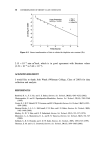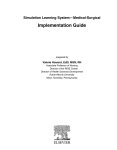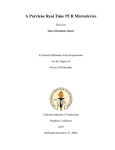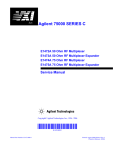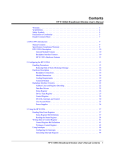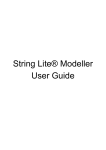Download Blast Resistant Glazing Design 2007 User`s Manual
Transcript
Table of Contents Chapter I: 1.1 1.2 Introduction Introduction............................................................................4 Features ..................................................................................4 Chapter II: 2.1 2.2 2.3 2.4 2.5 2.6 Getting Started Opening Blast Resistant Glazing Design 2007......................7 Disclaimer and Limitations....................................................7 Tool Bar……………………………………………………..11 Starting a New Design ...........................................................11 Opening an Existing Design ..................................................12 Saving a Design .....................................................................14 2.6.1 Save Project ...............................................................15 2.6.2 Save As ......................................................................15 System of Units......................................................................16 Printing of Document.............................................................17 Project Information Access ....................................................................................19 Description.............................................................................20 Closing the Project Information Window..............................20 2.7 2.8 Chapter III: 3.1 3.2 3.3 Chapter IV: 4.1 4.2 4.3 4.4 4.5 Design Input Access ....................................................................................21 User Input...............................................................................23 Design Blast Details...............................................................24 4.3.1 UFC 4-010-01 ............................................................25 4.3.2 ISC/GSA ....................................................................25 4.3.3 User-Defined..............................................................25 Rectangular Dimensions ........................................................25 Glass Constructions ...............................................................26 4.5.1 Single Glazed Lite......................................................26 4.5.1.1 Annealed Glass ...........................................27 4.5.1.2 Heat Strengthened Glass .............................27 4.5.2 Double Glazed Insulating Unit ..................................27 4.5.2.1 Outboard Lite ..............................................27 4.5.2.2 Inboard Lite.................................................28 4.5.2.3 Air Space.....................................................28 4.5.2.4 Other Definitions ........................................29 1 Chapter V: 5.1 5.2 5.3 5.4 5.5 5.6 Design Results Access ....................................................................................30 Design Load Details...............................................................31 5.2.1 Equivalent 3- Second Duration Design Load ............31 5.2.2 Load Resistance .........................................................32 5.2.3 Approximate Maximum Air Blast Pressure...............32 Glazing Design.......................................................................33 5.3.1 PVB Interlayer Nominal Thickness ...........................33 Framing and Attachment Requirement..................................34 Comments ..............................................................................35 Closing the Design Results Window .....................................36 2 List of Figures Figure 2.1 2.2 2.3 2.4 2.5 2.6 2.7 2.8 2.9 2.10 2.11 2.12 3.1 3.2 4.1 4.2 4.3 4.4 4.5 4.6 4.7 5.1 5.2 5.3 5.4 5.5 5.6 Title Page Disclaimer and Limitations...................................................8 Tool Bar ...............................................................................11 New Project..........................................................................12 Save Changes to Design.......................................................12 Opening an Existing Project ................................................13 Open Window ......................................................................13 Save Project .........................................................................14 Save Project As ....................................................................14 Save As Window..................................................................15 System of Units....................................................................16 Print Project Report..............................................................17 Print Window.......................................................................18 Project Information Access..................................................19 Project Information Window ...............................................20 Minimized Design Input Window .......................................21 Design Input Access ............................................................22 Design Input Window ..........................................................23 Design Blast Details.............................................................24 Glass Constructions .............................................................26 Single Glazed Lite................................................................26 Double Glazed Insulating Units...........................................28 Design Results Window.......................................................30 Design Loads Details ...........................................................31 Glazing Design Section........................................................33 Framing and Attachment Section.........................................34 Comment Section, Within AM E 1300-02 ..........................35 Comment Section, Beyond ASTM E-1300-02 ....................35 3 CHAPTER I Introduction 1.1 Introduction Blast Resistant Glazing Design 2007 uses ASTM E 1300 and ASTM F 2248 standards to size rectangular laminated glass and insulating glass constructions fabricated with at least one laminated glass lite to resist an explosive threat. The software finds its basis in the paper “Considerations for Blast Resistant Design,” by H. Scott Norville and Edward J. Conrath published in the ASCE Journal of Architectural Engineering published September 2001; ASTM F 2248, Standard Practice for Specifying an Equivalent 3-Second Design Loading for Blast Resistant Glazing Fabricated with Laminated Glass; and ASTM E 1300, Standard Practice for Determining Load Resistance of Glass in Buildings. 1.2 Features Blast Resistant Glazing Design 2007 uses an UFC 4-010-01 Exp Wt I, UFC 4-010-01 Exp Wt I, ISC Medium Threat Level (GSA Level C), an ISC Higher Threat Level (GSA Level D), or a user defined threat level in terms of an equivalent TNT charge size and standoff distance. Blast Resistant Glazing Design 2007 converts this threat level to a 3-second duration equivalent design load following procedures in ASTM F 2248, and sizes laminated glass or symmetric insulating glass fabricated with at least one laminated glass lite using procedures in ASTM E1300 to resist the 3second duration equivalent design load. The resulting single laminated glass lite or insulating glass unit, when supported properly, will fracture safely and provide blast resistance in explosions up to the design threat level. For larger explosions, the blast resistant glazing still affords some 4 protection. Blast Resistant Glazing Design 2007 provides recommendations concerning the appropriate size of a sealant bead to attach the blast resistant glazing to the window frame and gives forces necessary to design connections to attach window frames to the structure. As input to Blast Resistant Glazing Design 2007, the user provides the threat level, the rectangular dimensions of the fenestration, and the desired window glass construction, i.e., single laminated glass or an insulating glass unit fabricated with at least one laminated glass lite. The window frame must support the blast resistant glazing continuously along all four sides. Blast Resistant Glazing Design 2007 uses the following constructions for blast resistant glazing: single laminated glass, fabricated with either annealed or heat strengthened glass plies and a PVB interlayer, or insulating glass units. The program allows one of the two following insulating glass constructions: (1) a monolithic glass lite facing the outside of the building and a laminated glass lite facing the inside, or (2) laminated glass for both lites of the insulating glass unit. As stated above, all glass plies can be either annealed or heat strengthened glass, not fully tempered. Blast Resistant Glazing Design 2007 displays the equivalent 3-second duration design loading, the approximate maximum air blast pressure, the nominal glass thickness for a single laminated glass lite or the nominal thicknesses for the lites that comprise the insulating glass unit required to resist the 3-second duration equivalent design loading according to ASTM E1300 after it completes the blast resistant glazing design calculation. Blast Resistant Glazing Design 2007 always uses lites having equal nominal thicknesses in insulating glass units. The program also displays the recommended size of the structural sealant bead to attach the blast resistant glazing to the window frame, and the loads required to design the window frame members and to connect the window frame to the building. 5 Blast Resistant Glazing Design 2007 prints a blast resistant glazing report with the design load details, the project details, the glazing information, the glass construction, design load details, and the framing and attachment requirements and loads. 6 CHAPTER II Getting Started 2.1 Opening Blast Resistant Glazing Design 2007 Blast Resistant Glazing Design 2007 opens in three ways. (1) The user can follow the path Start / All Programs / Standards Design Group, Inc / Blast Resistant Glazing Design 2007; (2) the user can double click on a program file with the extension “.brd”; or (3) if the user creates a program shortcut on the desktop, the user can open the program by double clicking on this shortcut. 2.2 Disclaimer and Limitations When the program opens, the “Disclaimer and Limitations” window appears as shown in Figure 2.1. Before continuing, the user must read and understand the disclaimer and the limitations of the software. After reading the program limitations, click on the “I have read and understand the limitations of this software” check box after reading and understanding the limitations of Blast Resistant Glazing Design 2007. Press the “Ok” button to continue. 7 Figure 2.1: Disclaimer and Limitations 8 The Disclaimer and Limitations states: Procedures followed in determining the load resistance of this window glass is in accordance with ASTM E1300-04. When the load resistance of a window falls beyond the limits of ASTM E 1300-04, the software will provide a statement to that effect. Procedures followed in determining the equivalent 3-sec blast design load are in accordance with ASTM F 2248 "Standard Practice to Specify an Equivalent 3-second Duration Design Loading for Blast Resistant Glazing Fabricated with Laminated Glass". Upon the release of the final draft of this standard, this software program will be updated to comply with any changes that might be made. In the event a blast occurs of design size or smaller, this design satisfies GSA Level 3A in that it will fracture safely. This software can be used to design blast resistant glazing fabricated with laminated glass subject to the following conditions: 1. The glass is free of edge and surface damage. 2. The blast resistant glazing assembly is continuously supported along all four edges. 3. The software user has the responsibility of selecting the correct procedures for the required application from the software. 9 4. The stiffness of members supporting any glass edge shall be sufficient that under an equivalent 3 sec. design load, edge deflections of glazing shall not exceed L/160, where L denotes the length of the supported edge. 5. The non-factored load values for laminated glass are representative of test data and calculations performed for polyvinyl butyric interlayer at a temperature of 50º C (122° F). For other limiting conditions that may apply, refer to Section 5 of ASTM E1300, local building codes, and ASTM F 2248 "Standard Practice to Specify an Equivalent 3-second Duration Design Loading for Blast Resistant Glazing Fabricated with Laminated Glass". SDG does not guarantee and disclaims any responsibility for any particular results relating to the use of the Blast Resistant Glazing Design 2007 Software Program. SDG disclaims any liability for any personal injury or any loss or damage of any kind, including all indirect, special, or consequential damages and lost profits, arising out of or relating to the use of the Blast Resistant Glazing Design 2007 Software Program. 10 2.3 Tool Bar The tool bar shown in Figure 2.2 allows one click access of many important features in Blast Resist Glazing 2007. The New Design icon allows the user to create a new design as described in Section 2.4. The Open Design icon allows the user to open a previously saved blast resistant glazing design as described in Section 2.5. The Save Design icon allows the user to save the current design as described in Section 2.6. The Print Design icon allows the user to print a design report as described in Section 2.8. The System of Units icons allow the user to toggle between US and SI units with a click of the button as described in Section 2.7. New Design Open Design Save Design Print Design System of Units Figure 2.2 Toolbar 2.4 Starting a New Design To start a new design, click File > New Project as Figure 2.3 shows. If a current project is open, the program asks “Save changes to Design before closing?” as Figure 2.4 shows. Press “Yes” button to save current project information before starting the new project. This action brings up either the “Save As …” or the “Save ...” dialog box. Use of these dialog boxes is described below. Press “No” button to discard current project information. This action resets all values to default settings. Press “Cancel” button to return to the current project information. 11 Figure 2.3: New Project Figure 2.4: Save Changes to Design 2.5 Opening an Existing Design The user can open an existing document in three ways. The first consists of pressing “File/Open Project…” as Figure 2.5 shows. The second consists of pressing the Open File button on the tool bar. The “Open” window (Figure 2.6) then appears. Follow the path to the desired project file and press the “Open” button on the bottom of the “Open Window” as Figure 2.7 shows. This opens the details of the design from the file. If the Open Project button was pressed by mistake, simply press the “Cancel” button and the programs returns to the current project. The third consists 12 of double clicking on the desired file without first opening the program. This action automatically opens Blast Resistant Glazing Design 2007 with the design information from the previously saved file loaded. Figure 2.5: Opening an Existing Project Figure 2.6: Open Window 13 2.6 Saving a Design To save a design, press File > Save Project (Figure 2.7) or File > Save Project As …(Figure 2.8). Pressing the Save button produces the same result as pressing File > Save Project. Figure 2.7: Save Project Figure 2.8: Save Project As 14 2.6.1 Save Project If the project has not been previously saved, the program brings up the “Save As” window as Figure 2.9 shows. Type in a file name to the left of the “Save” button and press the “Save” button to save the current project. If the project has been previously saved, the program automatically writes the data for the current project to the previously saved file. Figure 2.9: Save As Window 2.6.2 Save As Pressing File > Save Project As… always brings up the “Save As” window shown in Figure 2.9. This allows the renaming of the current project or the saving of a new project. Follow the steps in Section 2.4 of the document to save a file using the “Save As…” command. 15 2.7 System of Units Blast Resistant Glazing Design 2007 uses both US and SI units. The program allows the user to toggle between the US and SI systems of units, automatically updating all data in the current design. To change the system of units click on the path Tools > System of Units as Figure 2.10 shows. Blast Resistant Glazing Design 2007 also has System of Units buttons on the toolbar (Figure 2.2). Press the desired unit system button on the tool bar. Figure 2.10: System of Units 16 2.8 Printing a Document Blast Resistant Glazing Design 2007 prints a design report for the current project. To print a design report press File > Print Project Report as Figure 2.11 shows or press the button located on the toolbar (Figure 2.2). A “Print” dialog box appears, shown in Figure 2.12. Select the current printer and press the “Print” button to print the current blast resistant glazing design. Figure 2.11: Print Project Report 17 Figure 2.12: Print Window 18 CHAPTER III Project Information 3.1 Access To access the “Project Information” window click on File > Project Info, Figure 3.1. Figure 3.1: Project Information Access 19 3.2 Description The “Project Information” window (Figure 3.2) contains reference information about the design project that includes the project name, location and designer. The window provides a field for comments and other information relevant to the project. This information is displayed on the report. Project Information data are for the user’s information only. The software does not require this information to perform design calculations. Figure 3.2: Project Information Window 3.3 Closing the Project Information Window To close the Project Information window click on the “Done” button or press the “X” button at the top, right-hand corner of the window. Although the window is closed, the program stores all the information for the current project. To edit the data in this window, reopen the Project Information window and edit as necessary. 20 Chapter IV: Design Input 4.1 Access Upon startup of the program, Blast Resistant Glazing Design 2007 automatically displays the “Design Input” window. From time to time the user might close or minimize this window. Although this window is closed, Blast Resistant Glazing Design 2007 stores all the information for the current project. If the window is minimized, Blast Resistant Glazing Design 2007 places the window in the bottom left hand corner of the window as shown in Figure 4.1. Press the Restore button to activate the window. If the window is closed, the program hides the window. To access the “Design Input” window select on Input > Individual Lite as Figure 4.2 shows. Figure 4.1: Minimized Design Input Window 21 Figure 4.2: Design Input Access 22 4.2 User Input Figure 4.3 shows the “Design Input” window. This window facilitates input of the required information for a blast resistant glazing design. window has three sections: This the “Design Blast Details” section, the “Rectangular Dimensions” section, and the “Glass Construction” section. Figure 4.3: Design Input Window 23 4.3 Design Blast Details The “Design Blast Details” section allows the user to define the design blast threat by selecting an UFC 4-010-01 Exp Wt I, UFC 4-010-01 Exp Wt II, ISC Medium Threat (GSA Level C), an ISC High Threat (GSA Level D), or a User-Defined blast as shown in Figure 4.4. The UFC 4-010-01 threat types require a user-defined standoff distance. The ISC/GSA threat types do not require any user input. Lastly, a User-Defined blast requires an equivalent hemispherical TNT charge size and standoff distance to calculate the equivalent 3-second duration equivalent design load acting on the glazing. Figure 4.4: Design Blast Details 24 4.3.1 UFC 4-010-01 Choosing “UFC 4-010-01 Exp Wt I” or “UFC 4-010-01 Exp Wt II” defines a blast threat consistent with Unified Facilities Criteria, as defined by the US Government. 4.3.2 ISC/GSA Choosing “ISC Medium Threat – (GSA Level C)” or “ISC Higher Threat – (GSA Level D)” defines a blast threat consistent with existing US Government definitions. 4.3.2 User-Defined A user-defined blast requires the user to input the equivalent hemispherical TNT charge size and standoff distance associated with a design threat. Blast Resistant Glazing Design 2007 accepts TNT charge sizes ranging from 10 lb. (4.54 kg) to 2000 lb. (907 kg). 4.4 Rectangular Dimensions The Rectangular Dimensions section allows the user to input the size of the fenestration to be glazed. Ambiguity exists in the design community as to whether these dimensions represent the size of the blast resistant glazing itself or the raw opening size. This is a question that the glazing designer must answer. In general, using the raw opening dimensions will result in acceptable, if conservative, glass thickness selection 25 4.5 Glass Constructions Blast Resistant Glazing Design 2007 designs for glazing constructions of a single glazed lite or double glazed insulating unit as indicated by Figure 4.5. Figure 4.5: Glass Constructions 4.5.1 Single Glazed Lite For a single glazed lite, Blast Resistant Glazing Design 2007 facilitates designs only with laminated glass fabricated with annealed or heat strengthened glass plies as shown in Figure 4.6. The program uses only laminated glass with nominal 6 mm (1/4 in.) or larger thickness for blast resistant glazing design. Figure 4.6: Single Glazed Lite 26 4.5.1.1 Annealed Glass Annealed Glass consists of a flat monolithic glass lite of uniform thickness having residual surface stresses that are nearly zero. 4.5.1.2 Heat Strengthened Glass Heat strengthened glass consists of a flat monolithic glass lite of uniform thickness that has been subjected to a special heat treatment process where the residual surface compression ranges from 24 MPa (3500 psi) to 52 MPa (7500 psi). 4.5.2 Double Glazed Insulating Unit Any combination of two glass lites enclosing a sealed space filled with air or other gas. 4.5.2.1 Outboard Lite The outboard lite of an insulating glass unit is the lite that faces toward the outside of the building. Blast Resistant Glazing Design 2007 allows the user to select laminated or monolithic glass fabricated with annealed strengthened glass for the outboard lite. or heat To select the outboard lite as monolithic, uncheck the box marked “check for laminated” shown in Figure 4.7. 27 4.5.2.2 Inboard Lite The inboard lite is the lite of an insulating glass unit that faces toward the inside of the building. Consistent with ASTM F 2248-03, Blast Resistant Glazing Design 2007 requires laminated glass for the inboard lite. Blast Resistant Glazing Design 2007 allows fabrication of the laminated glass with either annealed or heat strengthened glass. Figure 4.7: Double Glazed Insulating Unit 4.5.2.3 Air Space The air spaced is the sealed space in an insulating glass unit. The air space thickness consists of the distance between the glass lites in the insulating glass in inches (mm). The program uses a default value 0.5 in. (12.7 mm) for the air space. The user can change this value. 28 4.5.2.4 Other Definitions For other definitions related to glass and glazing, refer to ASTM E 1300 or ASTM C 1048. 29 Chapter V Design Results 5.1 Access To access the “Design” window, click the “Calculate” button on the Design Input window shown in Figure 5.1. This calculates the nominal thickness(es) of the blast resistant glazing, the recommended size of the structural sealant bead, and the uniformly distributed loads required to design the window glass frame and attach it to the structure. Figure 5.1: Design Results Window 30 5.2 Design Load Details The “Design Load Details” section (Figure 5.2) of the “Design Results” window, displays the equivalent 3-second duration design load, the load resistance of the blast resistant glazing, and the approximate maximum air blast pressure. (When applicable) Figure 5.2: Design Load Details 5.2.1 Equivalent 3–Second Duration Design Load Blast Resistant Glazing Design 2007 uses the procedures in ASTM E 2248 to determine the equivalent 3-second duration design load for the blast resistant glazing. It then follows procedures in ASTM E 1300 to determine the required glazing thickness(es) for the blast resistant glazing so that its load resistance exceeds the equivalent 3-second duration design load. This value is not given for UFC 4010-01 threat types. 31 5.2.2 Load Resistance The load resistance is the uniform lateral load that a glass construction can sustain based upon a given probability of breakage and load duration. ASTM E 1300 uses a 3-second load duration and a probability of breakage of 8 lites per 1000 at its first occurrence of the design loading. In the event of a blast loading occurring equal to the design threat, blast resistant glazing will fracture safely. If the load resistance of a blast resistant glazing falls beyond the limits of ASTM E 1300 for the current design, Blast Resistant Glazing Design 2007 displays a load resistance of “N/A” for the current design, and does not display the glazing design section explained in Section 5.2. 5.2.3 Approximate Maximum Air Blast Pressure If a “User-Defined” threat is selected, the program displays an approximate maximum air blast pressure. For UFC 4-010-01 and ISC/GSA threat types, the program does not display an approximate maximum air blast pressure for security reasons. 32 5.3 Glazing Design The glazing design (Figure 5.3) section displays the calculated nominal thickness of glass that has load resistance greater than the equivalent 3second duration design load according to ASTM E1300. The program also displays the minimum nominal thickness of the PVB Interlayer for the each laminated glass lite. If the load resistance of a blast resistant glazing falls beyond the limits of ASTM E 1300 for the current design, the program does not display the “Glazing Design” section. Figure 5.3: Glazing Design Section 5.3.1 PVB Interlayer Nominal Thickness Blast Resistant Glazing Design 2007 determines the minimum nominal thickness for the PVB interlayer for each lite. For laminated glass with heat strengthened lites, the minimum PVB interlayer nominal thickness shall be 1.52 mm (0.060 in.). For laminated glass with annealed glass lites, the minimum PVB interlayer nominal thickness shall be 0.76 mm (0.030 in.). 33 5.4 Framing and Attachment Requirements This section gives the design requirement for the framing and window attachment as Figure 5.43 shows. The first comment displays the recommended size of the structural sealant bead to attach the blast resistant glazing to the frame. The second comment gives the uniformly distributed static design load acting over the window surface area that the frame and its attachment to the building must resist in the event that the design blast occurs. Figure 5.4: Framing and Attachment Section 34 5.5 Comments The comment section (Figure 5.5) gives additional information for the blast resistant glazing design. The comment section explains the GSA and/or UFC 4-010-01 Hazard/Protection level for the design. A GSA level 3A is a “High Protection, Very Low Hazard” performance criterion. Under this criterion in the event of a design level blast the glazing cracks, and fragments enter the space and land on the floor no further than 3.3 ft (1.0 m) from the window. Figure 5.5: Comment Section, Within ASTM E 1300 If the load resistance of a blast resistant glazing falls beyond the limits of ASTM E 1300, the software only displays the equivalent 3-second design load and does not provide any other results. The comment block shown in Figure 5.6, states that for the particular design additional design considerations are required. Figure 5.6: Comment Section, Beyond ASTM E-1300-02 35 5.6 Closing the Design Results Window To close the design results window press the “Close” button on the bottom of the window or press the “X” button located on the top right-hand corner of the Design Results window. To recalculate the results, follow the instruction in Section 5.1 of this document. 36





































